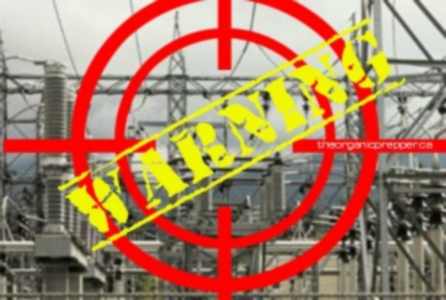Computer Tech Shows the DHS Just How Easy It Is to Breach the Security of the Power Grid
When the mainstream news warns of an event that is high on every prepper’s list of concerns, it might be time to double up on your efforts to be ready for it.
Again, the vulnerability of our power grid is in the news. This time, the threat is hackers. The LA Times published an article highlighting how alarmingly simple it was for a guy in North Carolina to breach the online security of American power stations.
Adam Crain assumed that tapping into the computer networks used by power companies to keep electricity zipping through transmission lines would be nearly impossible in these days of heightened vigilance over cybersecurity.
When he discovered how wrong he was, his work sent Homeland Security Department officials into a scramble.
Crain, the owner of a small tech firm in Raleigh, N.C., along with a research partner, found penetrating transmission systems used by dozens of utilities to be startlingly easy. After they shared their discovery with beleaguered utility security officials, the Homeland Security Department began sending alerts to power grid operators, advising them to upgrade their software.
The alerts haven’t stopped because Crain keeps finding new security holes he can exploit.
“There are a lot of people going through various stages of denial” about how easily terrorists could disrupt the power grid, he said. “If I could write a tool that does this, you can be sure a nation state or someone with more resources could.”
A year ago this month, a power station in San Jose, California was attacked by snipers. This incident was hushed up by the mainstream media and only recently reported on. Alarmingly, Jon Wellinghoff, the head of the Federal Energy Regulatory Commission, referred to it as “the most significant incident of domestic terrorism involving the grid that has ever occurred.” This was huge and we never even heard about it until months after the event. There are still no leads as to the perpetrators of the attack. Clearly this just goes to highlight that the grid is vulnerable to physical attack as well as cyber attack.
Even more alarming, the LA Times article goes on to say that Lloyd’s of London has deep concerns about the delicacy of the situation. This is of particular relevance because Lloyds boasts of specialising “in unusual risks”. And by unusual, I mean things like the taste buds of a famous food critic, the mustache of an Australian cricket player, the first automotive policy ever written, and even a space satellite. When they are concerned about covering a power station, there are deep issues.
Lloyds’ appraisers have been making a lot of visits lately to power companies seeking protection against the risk of cyberattack. Their takeaway: Security at about half the companies they visit is too weak for Lloyds to offer a policy.
“When Lloyds won’t insure you, you know you’ve got a problem,” said Patrick Miller, founder of the Energy Sector Security Consortium, a Washington-based nonprofit that advocates tougher cybersecurity measures for the electricity industry.
If you are new to preparedness, you may not realize the deeper implications of a long-term power failure. It goes far beyond the inconvenience of no lights and no television. In the event of a grid failure that is widespread and lasts for more than a week or two, these problems will occur for millions of Americans:
- Food will spoil quickly in warm weather because of lack of refrigeration.

- You won’t be able to get fuel for your car because most pumps are run by electricity.
- Some homes will no longer have running water and the toilets won’t flush because of electrical pump systems and water treatment facilities dependent on the grid – this will lead to serious sanitation issues.
- Some people depend on medication that must be refrigerated. On an even longer term basis, medications must be manufactured, and storefronts must be able to operate in order to dispense medications.
- Those with certain health issues require electrical assistance to survive: Devices like CPAP machines, respirators, some oxygen supplements, and some types of feeding tubes require electricity.
- And speaking of stores, if there is no power to run cash registers, in this world of electronic banking most stores will close, leaving patrons with no place to purchase needed items like food and water.
- Unless you have an off-grid heating system (like a woodstove, for example) you may find that without electricity to fuel your radiator or push heated air through a forced air system, you are completely without heat.
Homes today are rarely designed with the concept of life without the electrical grid. Renovations often take away the very things that could aid in a family’s survival if the power failed for the long term. For example, many people close off fireplaces or convert them to gas-fueled systems.
I wrote last year about how to prepare for an extended grid-down scenario, but the information bears repeating for those who are new to this lifestyle. You have far less to fear if you take control of the situation now. Ignore the whispers from Congress or the off-hand warnings from the mainstream media at your own peril.
Excerpted from You’ve Been Warned: Why You Need to Be Ready for Total Grid Failure
Find as many solutions as possible for the issues you would face if going for weeks (or longer) without power. You must stay warm, eat, and drink. Everything else is a bonus. You can live without the television, the video game console, the microwave in the kitchen, and the laptop.
Some people like to give arguments as to why they can’t resolve these issues. They live in an apartment, they rent, they have a limited budget….the list is as long as indefinite detention. The fact is, by realizing these things are necessary and refusing to face them and find solutions for your particular situation, you are setting your family up to suffer, and possibly even die, when it could be avoided.
A recent article encouraged readers who were new to prepping to start out by getting ready for a two week power outage. Apply the following information to create your own preparedness plan for the grid failure that is sure to come. Modify the suggestions to adapt them to your particular home, family, and climate.
Water
Everyone knows that clean drinking water is something you can’t live without. In the event of a disaster, the water may not run from the taps, and if it does, it might not be safe to drink, depending on the situation. If there is a boil order in place, remember that if the power is out, boiling your water may not be as easy as turning on your stove.
Each family should store a two week supply of water. The rule of thumb for drinking water is 1 gallon per day, per person. Don’t forget to stock water for your pets, also.
You can create your water supply very inexpensively. Many people use clean 2 liter soda pop bottles to store tap water. Others purchase the large 5 gallon jugs of filtered water from the grocery store. Consider a gravity fed water filtration device and water purification tablets as well.
Food and a Way to Prepare It
There are two schools of thought regarding food during a power outage. One: you need a cooking method that does not require the grid to be functioning. Two: you can store food that doesn’t require cooking.
If you opt for a secondary cooking method, be sure that you have enough fuel for two weeks. Store foods that do not require long cooking times – for example, dried beans would use a great deal of fuel, but canned beans could be warmed up, or even eaten cold.
Heat (Depending on Your Climate)
If your power outage takes place in the winter and you live in a colder climate, heat is another necessity. During the first 24 hours after a power outage, you can stay fairly warm if you block off one room of the house for everyone to group together in. Keep the door closed and keep a towel or blanket folded along the bottom of the door to conserve warmth. You can safely burn a couple of candles also, and in the enclosed space, your body heat will keep it relatively warm. As well, dress in layers and keep everything covered – wear a hat, gloves (fingerless ones allow you to still function), and a scarf.
However, after about 48 hours, that’s not going to be enough in very cold weather. You will require back-up heat at this point in certain climates. If you are lucky enough to have a source of heat like a fireplace or woodstove, you’ll be just fine as long as you have a supply of wood.
Consider a portable propane heater (and propane) or an oil heater. You have to be very careful what type of backup heat you plan on using, as many of them can cause carbon monoxide poisoning if used in a poorly ventilated area.
Learn more about off-grid heat options HERE.
Sanitation Needs
A common cause of illness, and even death, during a down-grid situation is lack of sanitation. We’ve discussed the importance of clean drinking water, but you won’t want to use your drinking water to keep things clean or to flush the toilet.
For cleaning, reduce your need to wash things. Stock up on paper plates, paper towels, and disposable cups and flatware. Keep some disinfecting cleaning wipes and sprays (I don’t recommend using antibacterial products on a regular basis, however in the event of an emergency they can help to keep you healthy.) Use hand sanitizer after using the bathroom and before handing food or beverages – there may be a lot more germs afoot in a disaster.
Look at your options for sanitation. Does your toilet still flush when the electricity is out? Many people discovered the hard way that the toilets didn’t work when the sewage backed up in the highrises in New York City in the aftermath of Hurricane Sandy. At our cabin, the toilet won’t flush without power because the pump is electric.
If you are on a septic system, with no risk of the toilet backing up into the house, simply store some water for flushing in the bathroom. (At the first sign of a storm, we always fill the bathtub for this purpose.) Add the water to the tank so that you can flush.
If this is not an option, another solution is to stock up on extremely heavy duty garbage bags (like the kind that contractors use at construction sites) and kitty litter. Place a bag either in your drained toilet or in a bucket. Sprinkle some kitty litter in the bottom of the bag. Each time someone uses the bathroom, add another handful of litter. Be very careful that the bag doesn’t get too heavy for you to handle it. Tie it up very securely and store it outside until services are restored.
Light
Lighting is absolutely vital, especially if there are children in the house. Nothing is more frightening than being completely in the dark during a stressful situation. Fortunately, it’s one of the easiest things to plan for, as well as one of the least expensive.
Some lighting solutions are:
- Garden stake solar lights
- Candles
- Kerosene lamps
- Flashlights (don’t forget batteries)
- Hand crank camping lantern
- Don’t forget matches or lighters
Tools and Supplies
Some basic items will make your life much easier during an emergency. Here are some things that are essential in the event of a power outage:
- Lighter/waterproof matches
- Batteries in various sizes
- Manual can opener
- Basic tools: Pliers, screwdriver, wrench, hammer
- Duct tape
- Crazy glue
- Sewing supplies
- Bungee cords
First Aid Kit
It’s important to have a basic first aid kit on hand at all times, but particularly in the event of an emergency. Your kit should include basic wound care items like bandages, antibiotic ointments, and sprays. As well, if you use them, keep on hand a supply of basic over-the-counter medications, like pain relief capsules, cold medicine, cough syrup, anti-nausea pills, and allergy medication. Particularly important if sanitation is a problem are anti-diarheal medications.
Special Needs
This is something that will be unique to every family. Consider the things that are needed on a daily basis in your household. It might be prescription medications, diapers, or special foods. If you have pets, you’ll need supplies for them too. The best way to figure out what you need is to jot things down as you use them over the course of a week or so.
Get Started Today
You can start right now – this very minute – all you have to do is grab a pad of paper and a pen.
- Begin by personalizing the suggestions above to fit your family’s needs and make a list of your requirements.
- Next, do a quick inventory – as I mentioned above, you may be surprised to see that you already have quite a few of the supplies that are recommended.
- Make a shopping list and acquire the rest of the items you need. If you can’t afford everything right now, prioritize the most important things first.
- Organize your supplies so that they are easily accessible when you need them. It’s hard to find seldom-used items in the dark.
When the lights go out, don’t be left to the not-so-tender mercies of those who would place themselves in charge. Maintain your independence by strengthening the position of your family. Take steps towards preparedness and self-sufficiency so that you won’t need the government’s assistance to weather the storm.
Survive Attack to Our Power Grid System (Weapon That Can Instantly End Modern Life in America)
Survival MD (Best Post Collapse First Aid Survival Guide Ever)
Backyard Innovator (A Self Sustaining Source Of Fresh Meat,Vegetables And Clean Drinking Water)
Blackout USA (EMP survival and preparedness)
Conquering the coming collapse (Financial advice and preparedness )
Liberty Generator (Build and make your own energy source)
Backyard Liberty (Easy and cheap DIY Aquaponic system to grow your organic and living food bank)
Bullet Proof Home (A Prepper’s Guide in Safeguarding a Home )
Family Self Defense (Best Self Defense Strategies For You And Your Family)
Survive Any Crisis (Best Items To Hoard For A Long Term Crisis)
Survive The End Days (Biggest Cover Up Of Our President)
Drought USA(Discover The Amazing Device That Turns Air Into Water)
SOURCE : The Organic Prepper
Daisy Luther is a freelance writer and editor. Her website, The Organic Prepper, offers information on healthy prepping, including premium nutritional choices, general wellness and non-tech solutions. You can follow Daisy on Facebook and Twitter, and you can email her at [email protected]



